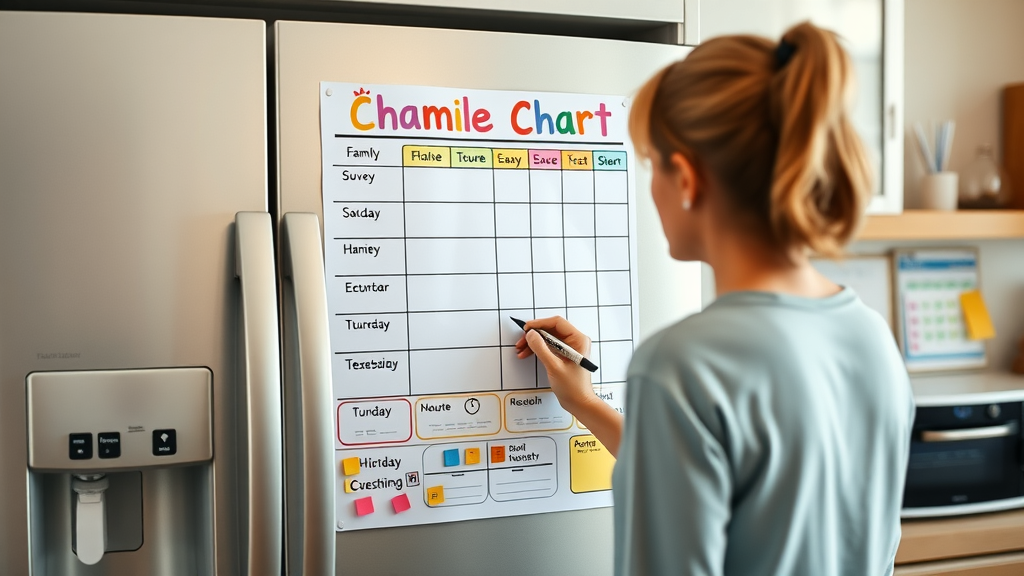Have you ever wondered if juggling every household chore alone is silently stealing your joy and well-being? Balancing work, home, and life as a woman can become a daily mountain of tasks. If you feel like you're running in circles just to keep your house running smoothly and stop feeling overwhelmed, you're not alone. This comprehensive guide will teach you how to delegate chores to avoid overwhelm using proven steps and uplifting strategies—to help you reclaim time for wellness, joy, and quality time with loved ones.

- What You'll Learn in This Guide on How to Delegate Chores to Avoid Overwhelm Today:
- Strategies to delegate chores and reduce overwhelm
- Approaches for assigning household tasks among family members
- How to create an effective chore chart
- Life skills developed through delegating tasks
- Steps to stop feeling overwhelmed by household chores
Are You Managing Every Household Chore Alone? Discover How to Delegate Chores to Avoid Overwhelm
Many women find themselves managing every household chore alone, often without realizing how deeply it impacts their wellness and peace of mind. In today’s fast-paced world, it’s easy to feel overwhelmed by the relentless stream of laundry, meal prep, clean-ups, and errands. Yet, learning to delegate chores to avoid overwhelm is one of the most powerful, compassionate gifts you can give to yourself—and your family. By consciously sharing responsibilities, you invite cooperation, foster valuable life skills in your children, and create breathing room for your own self-care. This guide provides you with actionable steps, creative strategies, and real-life examples for delegating household tasks so you can experience less stress and more joy every single day. Imagine a home where everyone pitches in, tasks become teamwork, and moms can finally enjoy moments of genuine rest and happiness.
Understanding the Link Between Household Chores and Feeling Overwhelmed
It’s no secret that managing household chores can feel endless—especially when they all fall on your shoulders. Not only do these chores take up your precious time, but they can also lead to feeling overwhelmed, anxious, or even burnt out. This mental and emotional weight can chip away at your sense of wellness and sap your daily joy. The good news? By understanding the reasons behind this overload, you can take practical, female-empowering steps to lighten the load and promote a healthier, more joyful home environment. In this section, we’ll explore how the cycle of overwhelm begins and how breaking it through sharing and delegation can redefine what household success looks like for you and everyone in your home.
Why Women Often Shoulder the Burden of Household Chores
Though our culture is slowly shifting, women are still much more likely to carry the invisible work of home management. Social expectations, learned habits, and a desire for everything to run smoothly often encourage women to assume control over every household task by default. For many, the urge to be “Superwoman”—managing schedules, meal prep, cleaning, child care, and even feeding pets—can feel non-negotiable. However, constantly doing it all can drain your energy and leave little room for self-care or joy. Recognizing this dynamic is the first, essential step to changing it. When women feel safe to ask for help and share tasks, they teach their families not only about teamwork but also about respect and appreciation for everyone’s contribution. This change matters: when mothers model balanced responsibility, they set a healthy precedent for all family members, including older children and partners. That’s how you build a home where everyone thrives, and the burden doesn’t rest on only one set of shoulders.
Signs You May Be Feeling Overwhelmed by Household Tasks
Are you often exhausted, irritated, or feeling like you just can’t keep up? These are common signs of being overwhelmed by household chores. If your mind races with to-dos, your patience feels thin, or you resent the endless pile of laundry and cleaning, you’re not alone—and these feelings are valid. Overwhelm often shows up as forgetfulness, snapping at family members, or skipping time for yourself because there’s always “just one more thing.” You might notice that even enjoyable activities lose their appeal if the mess never stops, and it becomes hard to set boundaries around your own needs. The truth is that no one should have to shoulder the household alone. Learning to delegate is the first step to reclaiming both peace and pleasure at home. When you give yourself permission to share chores, you give your mind space to rest and your family a chance to step up and learn valuable life skills.
"When you delegate chores to avoid overwhelm, you don’t just share tasks—you nurture wellness and joy in your home." – Wellness Coach

The Benefits of Delegating Tasks for Women’s Wellness and Joyfulness
- Improved mental wellness through sharing responsibilities
- Fostering life skills in all family members
- Making household chores more manageable and enjoyable
When you choose to delegate chores to avoid overwhelm, you put yourself and your wellness first. The ripple effects are powerful: sharing household tasks improves overall mental wellness, creates time for other joys, and models essential life skills for every family member. Delegation can turn a mountain of isolation and stress into a landscape of teamwork and shared accomplishment. Children and partners learn to contribute and communicate, and moms finally experience both rest and recognition. Whether it’s designating daily tasks like dishes and laundry or weekly jobs like grocery shopping or yard work, dividing up chores means you don’t have to do it all. In fact, making chores more manageable and enjoyable can even transform quality time together as a family—especially when you celebrate successes or encourage each other along the way. By reimagining how you approach household management, you’re saying “yes” to a life that puts wellness, learning, and joy at the heart of your home.
Step-by-Step Process to Delegate Chores to Avoid Overwhelm
Transforming your household from one-woman show to all-in family teamwork is possible with intentional steps. Follow this process to delegate chores to avoid overwhelm and build a more harmonious, joyful home. Whether you’re starting fresh or refining your routine, these simple steps and tips will make life easier and help you stay on top of everything without burning out.
Assessing Your Current Household Chore Load
- List all household tasks you manage in a single day
- Identify repetitive versus occasional chores
- Highlight household chores that cause the most stress
Begin by taking inventory: write down every household chore you handle in a single day—from breakfast prep and school runs to laundry, vacuuming, and nighttime routines. Don’t forget “invisible” jobs such as managing schedules or paying bills. Next, sort your list by daily tasks versus those weekly or monthly household tasks. Notice which responsibilities feel the heaviest—these are likely your main sources of stress. Sometimes, simply seeing the full picture can help you realize just how much you’re managing, and where sharing could make a huge difference. This honest assessment is the foundation for creating a new plan that makes your life easier and brings more balance into your home.

Identifying Tasks that Can Be Delegated
- Break down chores by difficulty and urgency
- Recognize life skills that can be taught through specific chore delegation
- Understand which household tasks should remain your responsibility
With your master list in hand, begin sorting chores into categories: which are time-consuming, which are urgent, and which can help teach valuable life skills to family members. For example, older children might handle tasks like putting away laundry or feeding pets, while younger children can help with simple steps like setting the table. Recognize that not every household chore must be yours alone: dusting, clearing dishes, or watering plants can be shared out as age-appropriate responsibilities. The goal isn’t perfection, but to empower your family and teach essential life skills through daily routines. However, some things—like managing finances or confidential household matters—should stay yours. Setting these boundaries ensures you feel comfortable as you begin to delegate tasks and invite others to help.
Choosing the Right Family Member for Each Household Task
- Match tasks to family members’ ages and abilities
- Assign manageable household chores to children as life skills training
- Communicate expectations and responsibilities clearly with family members
Assigning the right household task to the right person can make all the difference. Consider each family member’s age, skill level, and availability when matching tasks. Younger children may be perfect for putting away toys or feeding pets, while teens can handle responsibilities like taking out trash, mowing the lawn, or helping with meal prep. Partners might tackle grocery shopping, budgeting, or yard work. Remember, clear communication is key—sit down together, express your needs and expectations, and make chore assignments a collaborative family meeting. Encourage questions, share why delegation matters for your wellness and joy, and celebrate efforts—not just results. When everyone feels their contribution counts, tasks become easier, and the whole family benefits.

How to Create an Effective Chore Chart to Delegate Chores to Avoid Overwhelm
Once you’ve determined what needs to be done and who’s best for which task, creating a clear, visible chore chart is your next step. A chore chart brings structure and accountability to your home and helps everyone track their daily and weekly responsibilities. Visual reminders make it easier to stay on top of routines—and when everyone can see the whole household’s efforts, you’ll feel connected and supported in your mission to avoid overwhelm.
Sample Chore Chart for Family Members
| Family Member | Daily Tasks | Weekly Tasks |
|---|---|---|
| Mom | Meal prep, laundry | Grocery shopping |
| Partner | Dishes, trash | Yard work |
| Teen Daughter | Pet care, clean room | Bathroom cleaning |
| Younger Son | Set/clear table | Vacuum living room |

Digital Tools and Apps to Streamline Chore Delegation
In today’s digital age, there are dozens of apps and tools designed to make delegating household chores easier than ever. Apps like Cozi, OurHome, or Todoist allow you to create and share chore charts, send reminders, and track progress—all from your phone or tablet. These digital chore charts are perfect for families with busy schedules (especially those with teens or tech-loving kids). By making the most of these tools, you can stay on top of household routines, ensure accountability, and adapt tasks as your needs change. Plus, using a digital system helps everyone “see” what’s been done and what needs attention, turning the act of delegating chores into a modern, family-wide effort that grows with your home and lifestyle.

Tips for Delegating Tasks Without Guilt and Cultivating Wellness
- Let go of perfectionism in household tasks
- Use positive reinforcement to motivate family members
- Prioritize self-care after delegating chores
Many women hesitate to delegate chores because of guilt or perfectionism. It’s easy to believe that only you can do things “right” or quietly worry that asking for help is a sign of weakness. The truth? Delegating household tasks is an act of self-care and empowerment. Remember, teaching your family to share responsibility builds long-term wellness and cultivates joy. Offer positive reinforcement and celebrate every effort, even if tasks aren’t perfect. After delegating, use the time you free up for rest, hobbies, or connecting with loved ones—restore the balance in your life and be gentle with yourself as you learn this valuable life skill. The more you practice delegation, the easier and more fulfilling it becomes, creating a home atmosphere centered on wellness rather than overwhelm.
"Delegating chores is an act of self-care and empowerment for every woman committed to her joy." – Women’s Wellness Author

Common Challenges in Delegating Household Chores and How to Overcome Them
Delegating tasks isn’t always seamless. You may encounter resistance from partners or children, or see tasks completed hastily—or not at all. Challenges like these are normal and surmountable. The key is to stay patient, communicate openly, and adjust your strategy as your family learns and grows. The next sections will help you address resistance and troubleshoot incomplete chores so your new system works for your family—not against it.
Addressing Resistance from Family Members
Some family members may push back because chores are new to them, or they’re unsure of your expectations. If that happens, try to understand their perspective and involve them in the decision-making process. Use family meetings to discuss changes, ask for feedback, and assign chores collaboratively. Be open to negotiating as long as household responsibilities are balanced—sometimes letting family members choose their own tasks or creating a chore rotation can help increase buy-in. Above all, reinforce that sharing household chores is about fairness, respect, and making life easier for everyone, including you—the heart of the home.
Troubleshooting Incomplete or Poorly Done Tasks
It’s normal for tasks to be missed or not done perfectly in the beginning. Instead of taking over or criticizing, use these moments as teaching opportunities. Provide guidance, offer feedback gently, and help your children or partner improve their skills over time. Check in periodically using your chore chart or app, and celebrate progress rather than demanding perfection. Remember: the goal is a balanced, joyful home, not a spotless one. Focusing on teamwork and learning helps everyone feel more engaged and responsible—and makes household management a shared, positive experience.
How Delegating Chores to Avoid Overwhelm Builds Essential Life Skills
Delegating chores isn’t just about keeping your home running smoothly—it’s about teaching children and even adults valuable life skills that last a lifetime. Every time you involve family members in housework, you plant seeds of responsibility, cooperation, and time management. Women who confidently delegate set an inspiring example for their families, ensuring children and teens are ready for self-sufficiency and success beyond home. Let’s look at two essential skillsets built through delegating tasks:
Teaching Children and Teens Responsibility Through Household Chores
Giving kids age-appropriate household chores is an important part of building character and responsibility. Small daily tasks—like making their bed, picking up toys, or feeding pets—instill a sense of ownership and pride in your children. Older children and teens benefit from tackling bigger jobs, such as cooking meals or managing their laundry. These tasks equip them with essential life skills and prepare them for adulthood. Delegating also strengthens bonds within the family and encourages conversations about fairness, respect, and the value of contributing to the home. Remember: every chore completed is one step toward independence and self-confidence for the next generation.

Developing Time Management and Teamwork in Your Family
Sharing household chores helps everyone—partner, children, and even you—develop essential time management and teamwork skills. By splitting up responsibilities and sticking to a regular schedule, your family learns to use calendars, meet deadlines, and cooperate to reach shared goals. Weekly chore rotations and family meetings can spark communication and strengthen relationships. Through this process, you’ll notice more understanding, respect for workload differences, and shared joy when tasks are completed. Most importantly, women who delegate household chores are investing in their family’s ability to work well together—inside and outside of the home—for a lifetime.
People Also Ask: How to Not Get Overwhelmed by Chores?
Answer: Divide tasks into manageable steps and delegate wherever possible. Establish and stick to a regular household chore schedule while prioritizing self-care. Using a household task chart can stop the feeling overwhelmed.
How to Delegate When Overwhelmed?
Answer: Start by listing all household chores, then use a chore chart to assign tasks to family members. Communicate your need for help, set clear expectations, and follow up with support.
How to Delegate Household Tasks Effectively?
Answer: Choose age-appropriate household tasks, provide clear instructions, and foster accountability using digital tools or chore charts. Feel empowered to delegate household chores and avoid overwhelm.
What Tasks Should You Not Delegate?
Answer: Do not delegate chores that require specialized skill, deal with confidential information, or impact safety. Examples include managing family finances, appliance repair, or sensitive household tasks.
Animated explainer video showing a busy woman creating a chore chart, discussing with her family, and everyone engaging in age-appropriate household tasks to promote teamwork, communication, and wellness.
Key Takeaways: Empower Yourself and Your Family Through Delegating Chores to Avoid Overwhelm
- Delegating household chores supports women’s wellness
- Chore charts simplify household task assignment
- Life skills grow through shared home responsibilities
- Overwhelm decreases when you ask for help
FAQs About How to Delegate Chores to Avoid Overwhelm
- How often should I update my household chore chart?
- Review and update your chore chart weekly or whenever your family’s routine changes to keep tasks relevant and manageable. - What’s the best way to motivate reluctant family members?
- Use positive encouragement, involve them in choosing tasks, and set up small rewards for follow-through to build motivation and ownership. - How do I initiate conversations about delegating household tasks?
- Schedule a relaxed family meeting to discuss sharing chores, explain the benefits for everyone, and invite feedback so everyone feels heard and included.
Watch real-life stories of women who found freedom, joy, and wellness by learning to delegate chores and nurture a happier, more connected family.
Embrace Joy: Start to Delegate Chores to Avoid Overwhelm Today
Subscribe for more strategies on how to be a successful woman in every area of your life: http://spotlightonyoursuccess.com
Reclaim your time, empower your family, and cultivate lasting wellness—delegate chores to avoid overwhelm and bring joy back to your home, starting today.
 Add Row
Add Row  Add
Add 




Write A Comment